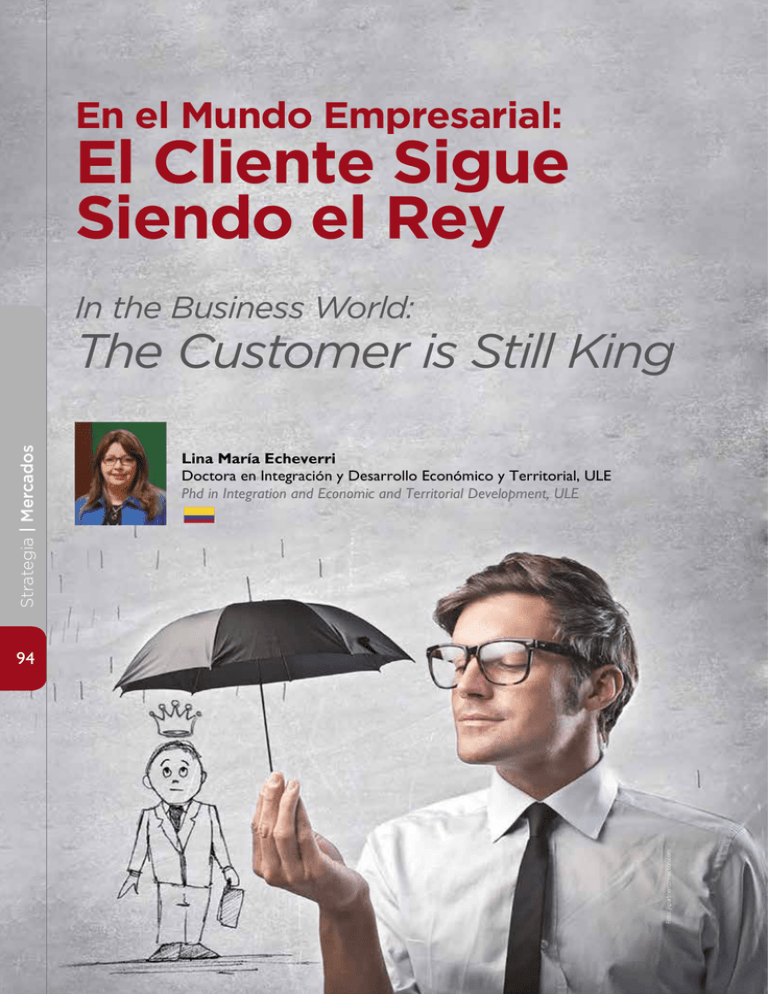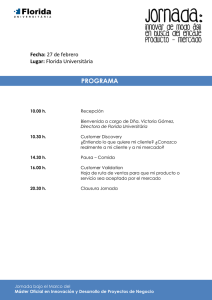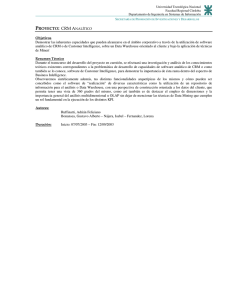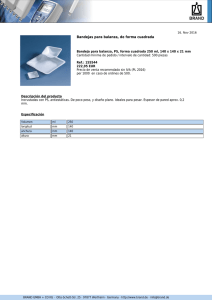El Cliente Sigue Siendo el Rey In the Business World
Anuncio

En el Mundo Empresarial: El Cliente Sigue Siendo el Rey In the Business World: Strategia | Mercados The Customer is Still King Lina María Echeverri Doctora en Integración y Desarrollo Económico y Territorial, ULE Phd in Integration and Economic and Territorial Development, ULE Foto: jlspartnerconnection.com 94 La respuesta a la pregunta precedente depende de una decisión estratégica, si usted contestó: ¡la marca!, su empresa se ha dedicado a concentrar su atención en incrementar el valor de sus marcas. Usted deberá destinar recursos financieros para proteger y capitalizar su equidad de marca. Incluso, deberá contratar servicios de consultoría que le prometen restaurar su “arquitectura de marca” que, según David Aaker, es el portafolio de marcas que recoge las funciones específicas de cada una y la naturaleza de sus relaciones con sus mercados. Foto: www.momokorea.com ¿ Qué es más valioso para una empresa: su marca o su cliente? Absolver esta pregunta con rigurosidad es decisivo para mirar el futuro. La respuesta solo puede ser: ¡el cliente! Los salarios, los beneficios, los equipos e incluso los presupuestos para publicidad y relaciones públicas proceden de los clientes; sin clientes, no puede haber rentabilidad, y sin rentabilidad no hay negocio. Así de simple, por el contrario, las marcas pueden tener poca relación con el éxito o la rentabilidad de las empresas. Un objetivo de marketing que se ha convertido en una obsesión para las empresas es conseguir el posicionamiento de sus marcas. Pero no se analiza en profundidad cómo el posicionamiento afecta la rentabilidad de la organización. Las marcas que han desaparecido del mercado no lo han hecho por falta de una estrategia de marca, sino por falta de clientes. En este sentido, es momento de W hat is most valuable for a company: your brand or its customer? Answer this question rigorously is decisive to look toward the future. The answer to the preceding question depends on a strategic decision, if you answered: the brand! your company has been dedicated to focus on increasing the value of their brands. You must allocate financial resources to protect and capitalize its brand equity. Even, you must hire consulting services that promise you restore its “brand architecture”, according David Aaker, is the portfolio of brands that includes the specific functions of each and the nature of their relationships with their markets. Unfortunately this answer is incorrect. El cliente de hoy es más exigente en lo que espera recibir, también más propenso a colaborar, dar y compartir. Today’s customer is more demanding in what expected to receive, also more prone to collaborate, give and share. The answer can only be: the customer! Wages, benefits, equipment and even budgets for advertising and public relations come from customers; without customers, there can be no profitability, and without profitability there is no business. So simple, by contrast, brands can have little relation to the success or profitability of the companies. An objective of marketing that has become an obsession for companies is the positioning of its brands. But it is not analyzed in depth as the positioning affects the profitability of the organization. The brands that have disappeared from the market have not done so due to lack of a brand strategy, but due to lack of customers. In this regard, it is time to Strategia | Mercados Esta respuesta desafortunadamente es incorrecta. 95 evaluate the traditional wisdom that has succeeded in enterprises into two terms such as: the “brand equity” and the “brand architecture”. It is time to change the language of marketing in the colombian companies to focus on structuring “customer equity” and the “customer architecture”. La equidad del cliente consiste en determinar cuáles son nuestros clientes más valiosos a través del Customer Lifetime Value (CLV). Esta herramienta es valiosa para la estimación del 20% de los clientes que generan el 80% de los beneficios, y para identificar el 15% de los clientes que, en promedio, no son rentables. Customer equity consists of determining what are our most valuable customers through the Customer Lifetime Value (CLV). This tool is valuable for estimating 20% of customers who generate 80% of the benefits, and to identify 15% of customers that, on average, are not profitable. La “arquitectura de clientes” representa una metodología estructurada para la identificación y entrega de valor económico y emocional a los clientes, se fundamenta en la aplicación de la tecnología, la formulación de estrategias bien definidas, las metas, los objetivos y las tácticas. La estrategia gira en torno a la segmentación de clientes. Lo ideal es que la segmentación se construya desde la “equidad de los clientes”, pero también que incluya variables de comportamiento y conducta de estos. El cliente de hoy es más exigente en lo que espera recibir, también más propenso a colaborar, dar y compartir. Una vez que los clientes se han segmentado en “gold”, “platinum”, “preferencial”, “vip” u otras categorías, las acciones de marketing deben orientarse a generar la diferenciación. The ‘customer architecture’ represents a methodology structured for the identification and delivery of economic and emotional value to customers, is based on the Foto: www.esmallbusinessassist Strategia | Mercados 96 evaluar la sabiduría tradicional que ha logrado que en las empresas se incorporen dos términos como son: la “equidad de marca” y la “arquitectura de la marca”. Es hora de cambiar el lenguaje de marketing en las empresas colombianas para concentrarse en estructurar la “equidad del cliente” y la “arquitectura de clientes”. Los productos, los servicios, los precios y las operaciones deben ser diferenciados de acuerdo al valor de cada cliente. Los objetivos de marketing se definen en torno a la maximización de la campaña promocional, la rentabilidad, el conocimiento del mercado y los resultados. Gran parte del éxito de las campañas promocionales que se aplican hoy está determinado por el número de clientes potenciales que se generan, sin considerar cuál es la rentabilidad de estos nuevos clientes y si el valor de la inversión en promoción justifica el valor de adquisición del cliente potencial. Pregúntese: ¿por qué desea adquirir un cliente no rentable? Evalúe los objetivos estratégicos, las estrategias de segmentación y de diferenciación en torno a una estrategia de crecimiento corporativa, con la finalidad de atraer clientes potenciales que compartan las mismas características de sus clientes rentables. La maximización de la rentabilidad se basa en la penetración de la marca. Entonces la pregunta pertinente será: ¿cuánto invierte su cliente en alguna categoría de los productos?, ¿cuál es la cuota del mercado?, ¿cuál es el costo inicial de adquisición inicial de clientes potenciales? application of technology, the development of welldefined strategies, goals, objectives and tactics. The strategy revolves around the customer segmentation. The ideal is that segmentation is built from the “equity of customers”, but also including behavior and conduct of these variables. Today’s customer is more demanding in what expected to receive, also more prone to collaborate, give and share. Once customers have been segmented into “gold”, “platinum”, “preferential”, “vip” or other categories, marketing activities must be directed to generate differentiation. Products, services, prices and operations must be differentiated according to the value of every customer. Marketing objectives are defined around the maximization of the promotional campaign, profitability, knowledge of the market and the results. Conocer qué quiere y qué necesita el cliente se resuelve implementando un programa denominado “voz del cliente” propuesto por la metodología Six Sigma. Esta metodología permite maximizar el conocimiento del mercado a través del registro de visitas, solicitudes, comunicaciones y colaboraciones con el cliente. Much of the success of promotional campaigns being implemented today is determined by the number of potential customers that are generated, without considering what the profitability of these new customers is and if the value of the investment in promoting justifies the purchase value of the potential customer. Ask yourself: Why do you want to acquire a not profitable customer? Evaluate the strategic objectives, strategies of segmentation and differentiation around a corporate strategy of growth, with the purpose of attracting potential customers that share the same characteristics of their profitable customers. La maximización de los resultados depende de la medición constante e infinita en la función de marketing. Mediante el uso de encuestas y auditorías, análisis financiero, presentación de informes operacionales y otros, las empresas deben medir el crecimiento, la retención y el ciclo de vida de cada cliente. The maximization of profitability is based on the penetration of the brand. The relevant question then will be: how much do your customer invest in any category of products? what is the market share?, what is the initial cost of initial acquisition of potential customers? and what offer marketing support the penetration of the product in the market? To know what you want and what the customer needs is resolved by implementing a program called the “voice of the customer” proposed by the Six Sigma methodology. This methodology allows to maximize the knowledge of the market through the registration of visits, applications, communications and collaborations with the customer. The maximization of the results depends on the constant and infinite measurement in the marketing function. Through the use of surveys and audits, financial analysis, operational reporting and others, companies should measure growth, retention, and the life cycle of each client. Los clientes no piensan o se preocupan por la “arquitectura de marca” de las empresas, la preocupación recae sobre el gerente de marketing, pues debe medir cómo la arquitectura de marca afecta la rentabilidad del negocio. Customers do not think or worry about the “brand architecture” of the companies, the concern rests with marketing manager, because you must measure how the brand architecture affects the profitability of the business. En ese contexto, si en su empresa consideran que el cliente es la base estratégica del negocio, transforme la “arquitectura de marca” en la “arquitectura del cliente”. Porque sin clientes y con una arquitectura de marca estructurada, su empresa puede derrumbarse como un castillo de naipes. No olvide esta lección de Philip Kotler: “El método por el que una empresa gana un cliente no se basa en tratar de vender algo, sino en crear una relación y un compromiso a largo plazo”. In that context, whether in your company considered that the client is the strategic basis of the business, transform “brand architecture” in the “customer architecture”. Because without customers and structured brand architecture, your company can collapse like a house of cards. Do not forget this lesson from Philip Kotler: “The method whereby a company wins a customer is not based on trying to sell something, but to create a relationship and a long term commitment.” Strategia | Mercados y ¿cuál es la oferta de marketing que sustentará la penetración del producto en el mercado? 97



